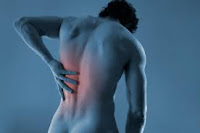Power Walking
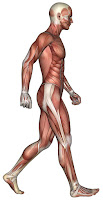
Walking in any of its guises is a natural, instinctive
method of moving. For most of us we have been walking since we were about 12
months old. As with so many things, it is easy to take for granted and,
particularly for those of us fortunate enough to be able to walk without
assistance, it is easy to become complacent about it. Indeed, with the
distances we typically travel increasing and the time we have available
becoming shorter, walking has become something that many see as an exercise
regime or method of enjoying the locale rather than a mode of transport. Far be
it from me to criticise this, indeed if it weren’t for two energetic dogs, I
too wouldn’t walk very far, preferring to run or cycle if it’s a trip for
pleasure and use the car or if not.
Walking, if done properly, with the thought and preparation
that we would give to any other form of atypical exercise, is a hugely
beneficial, wonderful way to spend time with friends or in solitary reflection,
to find pleasure in even the grottiest of weather while increasing our levels
of health and fitness. If, however, we don’t give it careful thought it causes
all sorts of problems which typically show themselves as back ache and sore
knees.
Power Walking takes casual walking up a notch in intensity
providing a superb, low-impact means of improving cardiovascular fitness and
endurance, total body strength, mobility and back health. It requires little in
the way of specialist kit and can be incorporated into ordinary everyday
activities or given its own allotted time and gives possibly one of the
quickest returns on investment in terms of positive impact for time spent for
the debutante than just about any other physical activity. While it is always
advisable to seek the advice of a medical practitioner before starting out on a
complete lifestyle change to ensure that your body would be able to cope with
sudden increases in activity levels, Power Walking does not carry the same
risks when starting out from inactivity that other, more extreme sports would
have. And yet, the benefits could be as good, if not better.
There are a few sensible things to consider before setting
out:
What to wear
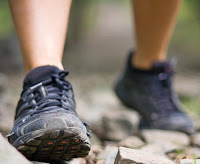 Footwear
Footwear is
obviously the major consideration – it needs to fit comfortably enough to
support your feet without slipping yet still allow room for your feet to spread
as they get hot. Remember this is Power Walking not hiking, you won’t be out
for hours so shoes or trainers which allow foot movement are more appropriate
than walking boots, but they should be suitable for the terrain you will be
walking on. Things to consider are grip and water resistance.
Supportive underwear
is extremely important. While we won’t be bursting into a 1980s aerobics
routine there will still be various parts of our bodies that need to be able to
move in a controlled manner. Ladies should consider their bra carefully. No
matter how large or small, too much movement is not only painful at the time
and risks chaffing, but a poorly supported bust can be a contributory factor in
mid to upper back problems. Gentlemen should consider supportive underwear too.
Briefs or shorts are personal preference, but again excessive movement should
be minimised to restrict chaffing, discomfort at the time and the risk of many
more serious complications later.
Outer layers also
need to be thought about carefully. You will get warm, indeed maybe even hot.
Again, to labour the point, Power Walking is not “la la la la la-ing” and you will be walking more briskly than a
typical stroll, or even a hike. Layering is a good idea so that you can take
clothes off as you warm up and you can easily put them back on again as you
cool down, but remember you do need to be able to carry them. Some people
prefer to be a little cold at the start knowing they will warm up to the
correct temperature, others prefer to feel comfortable at the outset and remove
layers as they get warmer. Hats and gloves should be thought about carefully
here too – it is highly probably that they will come off and very quickly even
in the winter.
Sun and hydration
Never underestimate the power of the sun. Wear a good
quality sunscreen on all parts of your skin that will be, or maybe, exposed
even in the winter. The sun doesn’t need to be shining and it doesn’t need to
be hot for your skin to be at significant risk from harmful UV. In the Summer a
sun hat that protects the head, neck and face are to be recommended as are
sunglasses, indeed in some organised events these are mandatory.

As for hydration, a
water
bottle should never be carried in your hand. This is a dreadful habit which
causes terrible upper back problems and sometimes can manifest itself very
quickly. I can’t express myself strongly enough on this point. Don’t be fooled
into thinking that the donut shaped bottles are OK, or that you won’t be out
long enough to worry about it. They aren’t OK and you will be, even 10 minutes
is too long to be carrying anything as heavy as water. Remember water weights
1kg per litre without the weight of the bottle too. Water should be carried on
you back in a rucksack or Camelbak (again compulsory in many events). If you
haven’t got either of these but you have a coach or a trainer, then they will
carry it for you (if they don’t then sack them!).
So now we are ready to Power Walk. We just leap out of the
car and go, right? Well no, not quite. There are a few things to think about
Step 1: Always mobilise first, but don’t stretch – not yet!
Start by moving each joint in all the directions it is
intended to move in. You may well find that you do this instinctively anyway.
You are about to walk so focus on the lower body and be methodical.
Waggle, scrunch and splay your toes. Point and flex your
feet and rotate at the ankle in both directions and bend and straighten at the
knee. Lift one leg up and move it forwards and backwards and rotate the whole
leg at the hip. Don’t forget the second leg!
Gently bend forwards and backwards a little and rotate at
the waist and then gently rotate the arms at the shoulder, then roll the
shoulders bringing them all the way up to your ears and sliding your shoulder
blades down your back and changing direction. Finally rotate the head, take ear
to shoulders and look to one side just in front of your shoulder and repeat on
the other side. These last few bits can be done as you start to walk if you
prefer, and the whole thing takes only a few minutes. Time well spent!
Step 2: Warm up

Now you are ready to go, but slowly first, here we are
allowed a brief period of daisy picking as you start to warm up and think about
how your body feels and how it moves. Breathing calmly and comfortably, in
through your nose and out through your mouth, focus on your posture as you
start to move. Imagine a balloon on top of your head helping you stand tall and
upright, or a ribbon running down through your spine which holds you upright.
The moment your posture becomes “tall and lovely” you become lighter on your
feet, your tummy and your bottom naturally tighten slightly and you are better
able to use your feet to drive you forward as you move in the way that they are
designed.
Spend 5 minutes or so walking like this bringing your awareness to
how your feet are moving and to your tummy and bottom staying tighter and
standing a little taller.

 Step 3: Dynamic stretching
Step 3: Dynamic stretching
Every few steps start to introduce a lunge where you take a
wide step forward and drop the back knee down towards the ground, then drive
back up by squeezing the buttock of the back leg a little more. Repeat on the
other leg. After a few pairs of lunges do three or four sumo-style squats every
third step and then switch to ski-style squats.
About now you can introduce
some arm movements by bringing them up as you squat down. No fancy choreography
here, just simple, effective stretching.
Step 4: Now we are ready to Power Walk.

Power Walking uses the arms to drive you forwards. Bend at
the elbows and keep your body upright. If you are coordinated enough then it is
ideal to use opposite arm to leg but, to be frank, as long as the arms do not
cross your body then it really doesn’t matter that much. There are more
important things to think about. A helpful tip is to just touch your middle
finger tip to your thumb tip, barely touching, and this keeps the hands relaxed
and removes tension from the arms all the way up to the neck.
Take a stride forward and place the heel of the foot gently
down first then bend the whole foot to drive off the floor with your toes while
pulling back with your arms. Again, they don’t cross your body, instead they
are led backwards by the triceps. As you power up onto your toes your second
leg is starting to come forwards and as the front arm is going backwards so too
the second one is coming forwards.

Keep your head in a neutral position with your gaze two or
three steps in front of you. Don’t look at your feet – it’s too late they are
already going there! Your brain will have already clocked any hazards and
programmed you to avoid them. Trust it. It knows what it’s doing.
Relax, breathe, maintain good posture, talk to yourself,
your walking buddies or the dog and enjoy the next 40 to 45 minutes!
Step 5: Warm Down and Stretch
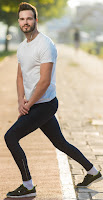

Maintaining the same good posture and walking form,
gradually bring the pace down for the last 5 to 10 minutes of the walk so that
you are back to daisy picking for the final stage.
Post exercise stretching is extremely important and hugely
under-rated but I firmly believe that as long as you are disciplined and do
your stretches relatively close to the end of your exercise (within an hour or
so) they don’t need to be immediately after if you feel uncomfortable doing
them in public, are getting cold or someone has put the coffee on.

I often close my
classes with the advice to go somewhere “less smelly and more comfortable to
stretch” – the shower, the coffee shop, the train, the office. Anywhere you
like as long as you do them. I really have laid on my office floor stretching
while on a Skype call (and I wasn’t on my own!), I have seen people on the
London Underground stretching next to their folding bikes and I have drunk my
coffee outside a bar while my cycling buddie lay on the payment to stretch her
hips.
Wherever you stretch, these are the static ones. The ones
that you hold, the ones that should never ever be done before exercise but so
sadly often are (just put an elastic band in the freezer then stretch it and
you’ll soon understand).
You need to focus on stretching the hamstrings and
calves (all the way down the back of the leg), the glutes (three sets of
muscles in your bottom), the hip flexors, the triceps (back of the arms) and
the shoulders.
Step 6: make a diary date for your next walk
 I have many friends who have leisurely, chilled out summer breaks and then throw themselves down the sides of snow covered mountains stuck to a plank of wood or two. They must be barking mad, I think, but then they describe their holiday to me, painting pictures of the most amazing scenery, the exhilaration of the descent, the strange sights from the cable cars and the relaxing après ski. So they aren't crazy after all. It sounds amazing and the photos they show are just awesome.
I have many friends who have leisurely, chilled out summer breaks and then throw themselves down the sides of snow covered mountains stuck to a plank of wood or two. They must be barking mad, I think, but then they describe their holiday to me, painting pictures of the most amazing scenery, the exhilaration of the descent, the strange sights from the cable cars and the relaxing après ski. So they aren't crazy after all. It sounds amazing and the photos they show are just awesome. They have had enough of coming down stairs backwards, of suffering niggly aches and pains that last for a lot longer than the buzz of the holiday and have decided to face up to the reality that, no matter how fit, strong and active they may be, they are about to put their body through a week of extreme sport for which it is ill-prepared. If they want to have a fantastic time, relax with friends and be able to walk without looking like they've got a couple of cabbages stuffed down their pants, then they need to put the effort in before they go.
They have had enough of coming down stairs backwards, of suffering niggly aches and pains that last for a lot longer than the buzz of the holiday and have decided to face up to the reality that, no matter how fit, strong and active they may be, they are about to put their body through a week of extreme sport for which it is ill-prepared. If they want to have a fantastic time, relax with friends and be able to walk without looking like they've got a couple of cabbages stuffed down their pants, then they need to put the effort in before they go.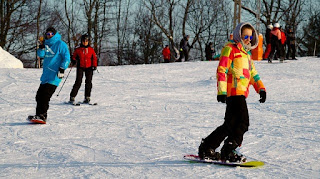 So, having seen the snow on the Pyrenees as I flew over them recently, I asked Paul how important is it to not just rock up and give it a bash.
So, having seen the snow on the Pyrenees as I flew over them recently, I asked Paul how important is it to not just rock up and give it a bash.

